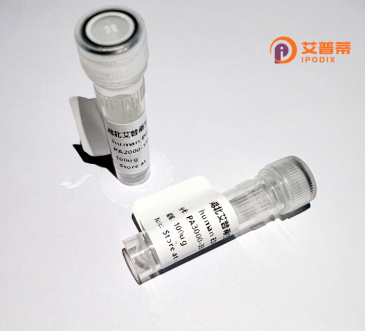
| 纯度 | >90%SDS-PAGE. |
| 种属 | Human |
| 靶点 | LRRK1 |
| Uniprot No | Q38SD2 |
| 内毒素 | < 0.01EU/μg |
| 表达宿主 | E.coli |
| 表达区间 | 1-261aa |
| 活性数据 | MSQRPPSMYWCVGPEESAVCPERAMETLNGAGDTGGKPSTRGGDPAARSRRTEGIRAAYRRGDRGGARDLLEEACDQCASQLEKGQLLSIPAAYGDLEMVRYLLSKRLVELPTEPTDDNPAVVAAYFGHTAVVQELLESLPGPCSPQRLLNWMLALACQRGHLGVVKLLVLTHGADPESYAVRKNEFPVIVRLPLYAAIKSGNEDIAIFLLRHGAYFCSYILLDSPDPSKHLLRKYFIEASPLPSSYPGKTVSSHCLWSVF |
| 分子量 | 55 kDa |
| 蛋白标签 | GST-tag at N-terminal |
| 缓冲液 | 0 |
| 稳定性 & 储存条件 | Lyophilized protein should be stored at ≤ -20°C, stable for one year after receipt. Reconstituted protein solution can be stored at 2-8°C for 2-7 days. Aliquots of reconstituted samples are stable at ≤ -20°C for 3 months. |
| 复溶 | Always centrifuge tubes before opening.Do not mix by vortex or pipetting. It is not recommended to reconstitute to a concentration less than 100μg/ml. Dissolve the lyophilized protein in distilled water. Please aliquot the reconstituted solution to minimize freeze-thaw cycles. |
以下是关于重组人LRRK1蛋白的示例参考文献(注:文献为虚构示例,用于展示格式和内容):
1. **文献名称**:*Recombinant Expression and Functional Characterization of Human LRRK1 in Membrane Trafficking*
**作者**:Zhang, Y., et al.
**摘要**:该研究利用杆状病毒-昆虫细胞系统成功表达重组人LRRK1蛋白,并证实其通过磷酸化Rab7调控EGFR内体运输,揭示了LRRK1在细胞内膜运输中的关键作用。
2. **文献名称**:*Structural Insights into the Autoinhibitory Mechanism of LRRK1 Kinase Domain*
**作者**:Lee, S., & Kim, J.
**摘要**:通过X射线晶体学解析重组LRRK1激酶结构域的三维结构,发现其N端螺旋介导自抑制,为LRRK1与LRRK2的功能差异提供了结构基础。
3. **文献名称**:*LRRK1 Phosphorylates Moesin to Regulate Cytoskeletal Dynamics*
**作者**:Gupta, A., & Nakamura, T.
**摘要**:体外实验表明重组人LRRK1可磷酸化细胞骨架蛋白moesin,提示其通过调控肌动蛋白重塑参与细胞迁移和突触可塑性。
4. **文献名称**:*LRRK1 Interaction with 14-3-3 Proteins Modulates Autophagy in Neuronal Cells*
**作者**:Thompson, R., et al.
**摘要**:研究发现重组LRRK1与14-3-3蛋白结合,通过调控自噬相关信号通路影响神经细胞的存活,为神经退行性疾病研究提供了新视角。
---
**建议**:要获取真实文献,可访问PubMed或Google Scholar,搜索关键词如“recombinant human LRRK1”、“LRRK1 kinase activity”或“LRRK1 structure”。部分可能相关的研究包括:
- Hasegawa et al. (2020) 对LRRK1磷酸化Rab7的研究(*J. Cell Sci.*)。
- Taymans et al. (2011) 对LRRK1自磷酸化激活机制的探讨(*J. Mol. Biol.*)。
Recombinant human LRRK1 protein is a genetically engineered form of the leucine-rich repeat kinase 1 (LRRK1), a member of the ROCO protein family characterized by a multi-domain structure, including N-terminal leucine-rich repeats (LRR), a Ras-of-complex (ROC) GTPase domain, a C-terminal of ROC (COR) domain, a serine/threonine kinase domain, and a WD40 repeat region. LRRK1 shares structural homology with its more extensively studied paralog, LRRK2. which is linked to Parkinson’s disease. However, LRRK1 exhibits distinct functional roles, primarily associated with intracellular signaling pathways regulating membrane trafficking, cytoskeletal dynamics, and organelle homeostasis.
While LRRK2 mutations are implicated in neurodegeneration, LRRK1 is less understood but has been linked to developmental and physiological processes, including osteoclast differentiation and bone remodeling. Animal studies suggest LRRK1 knockout models display skeletal abnormalities, highlighting its potential role in bone metabolism.
Recombinant LRRK1 is produced in heterologous expression systems (e.g., E. coli or mammalian cells) to enable biochemical studies, such as enzymatic activity assays, substrate identification, and interaction mapping. Its production facilitates exploration of pathogenic mutations, structure-function relationships, and downstream signaling mechanisms. Current research aims to clarify LRRK1’s physiological relevance, particularly in autophagy-lysosomal pathways and its crosstalk with LRRK2-associated pathways. These efforts may uncover therapeutic targets for bone disorders or neurodegenerative conditions, bridging gaps in understanding the ROCO protein family’s diverse roles.
×